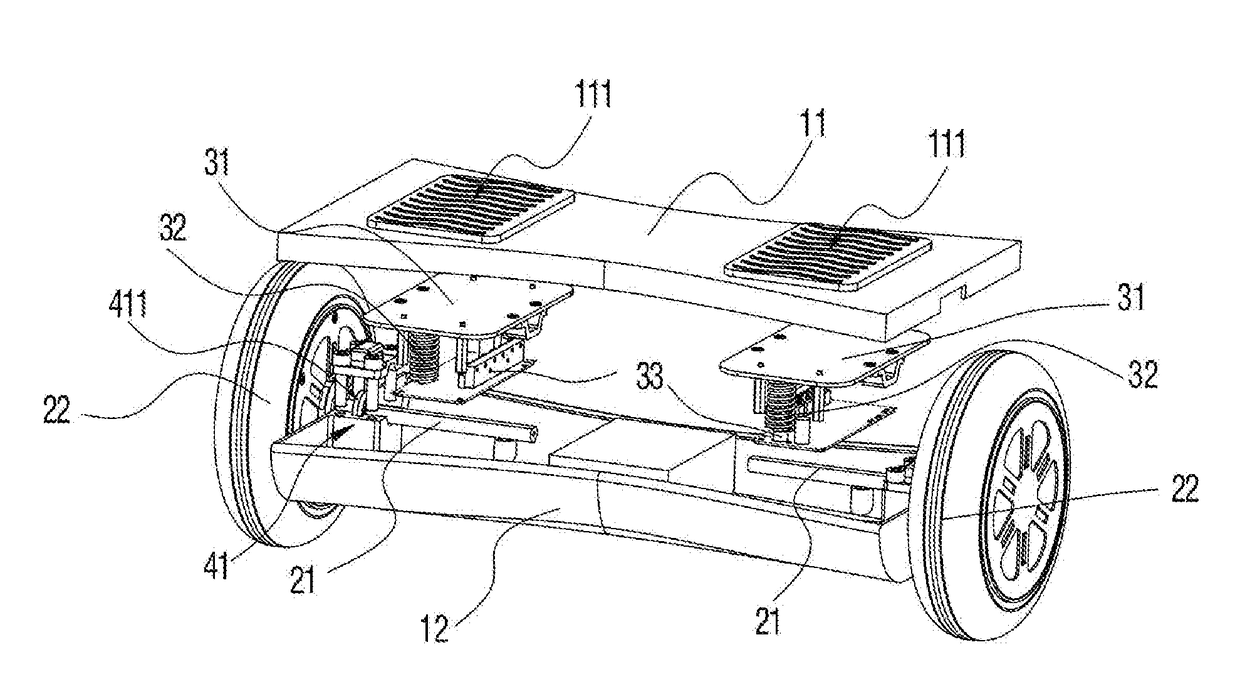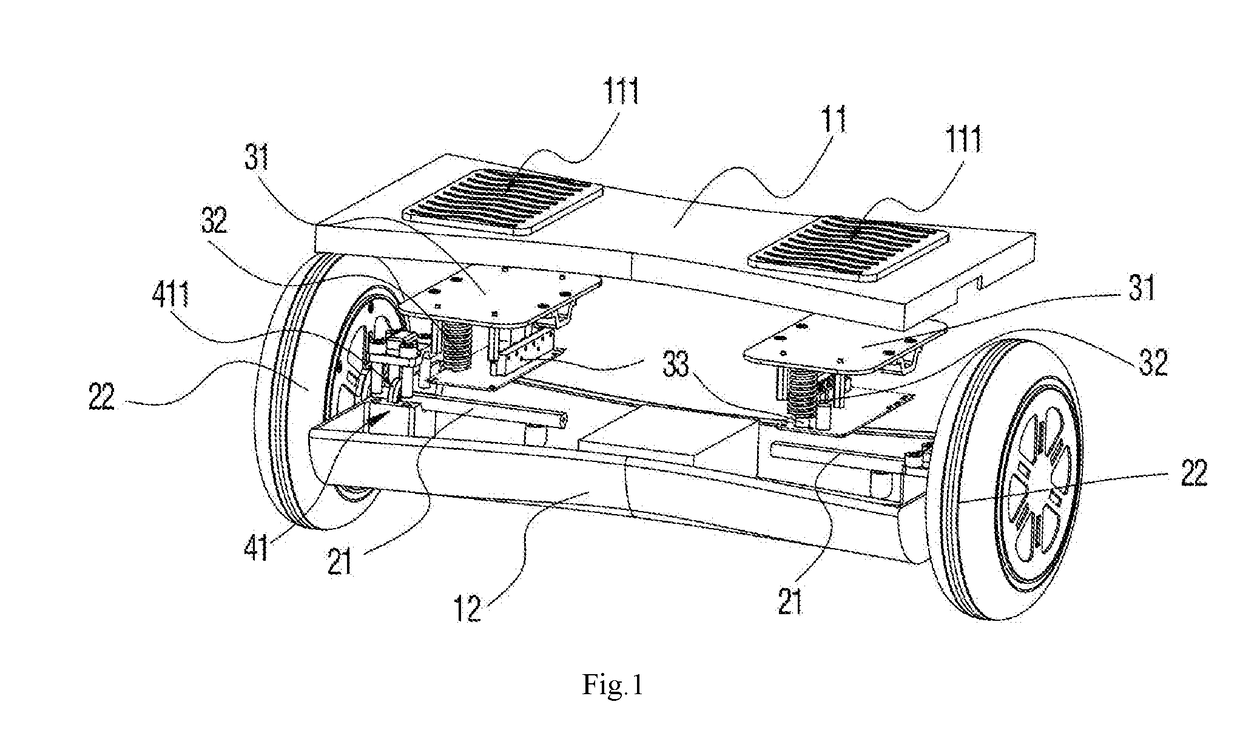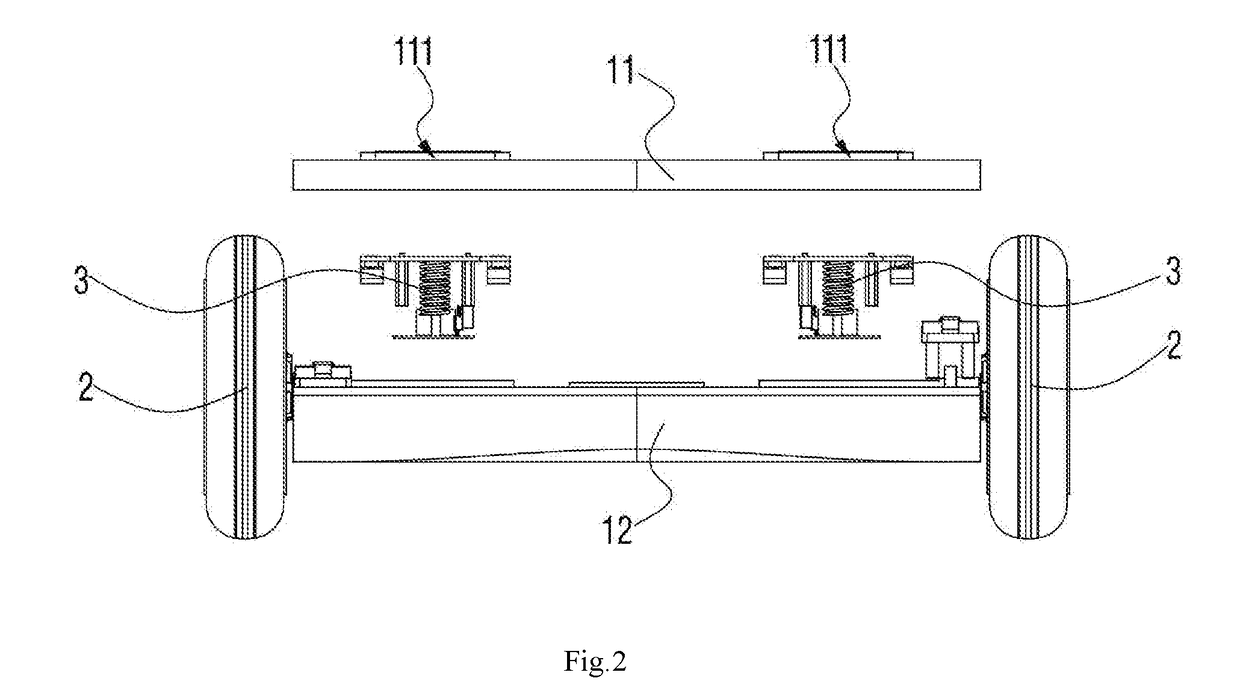Posture vehicle
a technology of vehicle body and body, applied in the field of electric vehicles, can solve the problems of poor balance experience, difficult to keep the vehicle body stable, and difficult to actually operate and control the user, and achieve the effect of low induction sensitivity
- Summary
- Abstract
- Description
- Claims
- Application Information
AI Technical Summary
Benefits of technology
Problems solved by technology
Method used
Image
Examples
embodiment 1
[0032]By referring to FIG. 1, FIG. 2 and FIG. 3, a posture vehicle provided in embodiments of the present invention comprises a vehicle body 1, two wheels 2 pivoted to the vehicle body 1, pedals 111 installed on the vehicle body 1, and two driving components 3, installed in the vehicle body 1, to drive the two wheels 2 to rotate with the movement of the pedals 111. Each wheel 2 comprises a stator fixing shaft 21 pivoted to the vehicle body 1 and a rotor-driven wheel 22 connected to the stator fixing shaft 21. Each of the two driving components 3 is electrically connected to its respective rotor-driven wheel 22. Two driving components 3 are installed in the vehicle body 1 at an interval in parallel and are respectively fixed and connected to the stator fixing shafts 21 corresponding to the rotor-driven wheels 22. When there is an inclined angle generated between each driving component 3 and a horizontal plane, a driving signal is output to the corresponding rotor-driven wheel 22 so t...
embodiment 2
[0039]By referring to FIG. 5, the posture vehicle provided in the present embodiment is similar to that in embodiment 1. The differences are that in the present embodiment:[0040]the two rotor-driven wheels 22′ are installed in the vehicle body 1′, and present an acute angle between each wheels. Two driving components 3′ are respectively located at outer sides of the two rotor-driven wheels 22′. Namely, a spacing between upper ends of the two rotor-driven wheels 22′ is larger than a spacing between lower ends of the two rotor-driven wheels 22′. In this way, a spacing between the two rotor-driven wheels 22′ is reduced so that a turning radius of the posture vehicle is smaller, which enables the vehicle suitable for travel in a narrow space.
[0041]Contents not described in the present embodiment are the same as those of embodiment 1, and are not repeated herein.
embodiment 3
[0042]By referring to FIG. 6, FIG. 6 is a stereoscopic structural schematic diagram of an posture vehicle 500 provided in the present embodiment. The posture vehicle 500 comprises a vehicle body 510, motors, supporting shafts 530 and driving components 540. The motors can adopt inner rotor motors, and can also adopt outer rotor motors. In the present embodiment, the motors are the outer rotor motors, and specifically are hub motors 520. Wheel bodies 521 are connected to rotors of the hub motors 520. Two hub motors 520 are respectively installed on the left side and the right side of the vehicle body 510. Two supporting shafts 530 are coaxially connected with stators of the two hub motors 520 respectively. The supporting shafts 530 are also simultaneously connected with the vehicle body 510 rotatably. In this way, the vehicle body can rotate relative to the hub motors 520. Two driving components 540 are installed in the vehicle body 510. One driving component 540 is located on the le...
PUM
 Login to View More
Login to View More Abstract
Description
Claims
Application Information
 Login to View More
Login to View More - R&D
- Intellectual Property
- Life Sciences
- Materials
- Tech Scout
- Unparalleled Data Quality
- Higher Quality Content
- 60% Fewer Hallucinations
Browse by: Latest US Patents, China's latest patents, Technical Efficacy Thesaurus, Application Domain, Technology Topic, Popular Technical Reports.
© 2025 PatSnap. All rights reserved.Legal|Privacy policy|Modern Slavery Act Transparency Statement|Sitemap|About US| Contact US: help@patsnap.com



